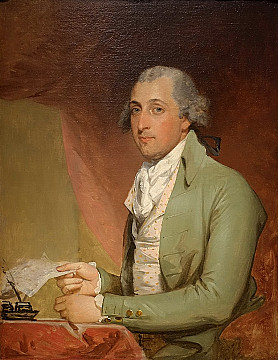William Bayard (1761-1826)
Shipping Merchant, of 6 State Street, New York City
He was born at Greenwich Village in Manhattan in the house in which his friend Alexander Hamilton died after his infamous dual in 1804. William's parents were Loyalists who removed to England after the Revolution. William remained in New York City and embarked on a career in shipping. In 1788, he went into business with his wife's brother-in-law, Herman LeRoy, co-founding LeRoy, Bayard & Co. Their headquarters were on Hanover Square and they traded from Europe to the East and West Indies. By 1800, theirs was the largest commercial house in the city. Shipping remained their primary source of revenue, but after the Embargo Act they diversified and invested in land in upstate New York. He was a Director of the New York Chamber of Commerce; President of the Bank of America; President of the Morris Canal Company; co-owner of the Tontine Coffee House; and, a large stockholder in the Oswego Lumber Association. He was Governor of the New York Hospital; a trustee of the Sailor's Snug Harbor; and, while Joseph Bonaparte lived in America, Bayard acted as his "principal banker".
The Bayards often toured Europe. William was fascinated by architecture and a passionate collector of art, bringing back many treasures. He lived at 6 State Street and kept his country house at Greenwich. In 1783, he married Elizabeth Cornell and they had 2-sons (William & Robert) and 5-daughters: (1) Kitty, Mrs Duncan Pearsall Campbell (2) Susan, Mrs Benjamin Woolsey Rogers (3) Maria, second wife of Duncan Pearsall Campbell (4) Eliza, Mrs Joseph Blackwell (5) Harriet, Mrs Stephen Van Rensselaer.
The Bayards often toured Europe. William was fascinated by architecture and a passionate collector of art, bringing back many treasures. He lived at 6 State Street and kept his country house at Greenwich. In 1783, he married Elizabeth Cornell and they had 2-sons (William & Robert) and 5-daughters: (1) Kitty, Mrs Duncan Pearsall Campbell (2) Susan, Mrs Benjamin Woolsey Rogers (3) Maria, second wife of Duncan Pearsall Campbell (4) Eliza, Mrs Joseph Blackwell (5) Harriet, Mrs Stephen Van Rensselaer.









